Remote Plasma Atomic Layer Deposition of SiNx Using Cyclosilazane and H2/N2 Plasma
Abstract
:1. Introduction
2. Materials and Methods
3. Results and Discussion
3.1. Process Window
3.2. Characteristics of SiNx Thin Films
4. Conclusions
Author Contributions
Funding
Conflicts of Interest
References
- Park, J.-M.; Jang, S.J.; Yusup, L.L.; Lee, W.-J.; Lee, S.-I. Plasma-enhanced atomic layer deposition of silicon nitride using a novel silylamine precursor. ACS Appl. Mater. Interfaces 2016, 8, 20865–20871. [Google Scholar] [CrossRef] [PubMed]
- Weeks, S.; Nowling, G.; Fuchigami, N.; Bowes, M.; Littau, K. Plasma enhanced atomic layer deposition of silicon nitride using neopentasilane. J. Vac. Sci. Technol. A 2016, 34, 01A140. [Google Scholar] [CrossRef]
- Andringa, A.-M.; Perrotta, A.; Peuter, K.; Knoops, H.C.M.; Kessles, W.M.M.; Creatore, M. Low-temperature plasma-assisted atomic layer deposition of silicon nitride moisture permeation barrier layers. ACS Appl. Mater. Interfaces 2015, 7, 22525–22532. [Google Scholar] [CrossRef] [PubMed]
- Faraz, T.; Drunen, M.; Knoops, H.C.M.; Mallikarjunan, A.; Buchanan, I.; Hausmann, D.M.; Henri, J.; Kessels, W.M.M. Atomic layer deposition of wet-etch resistant silicon nitride using Di(sec-butylamino) silane and N2 plasma on planar and 3D substrate topographies. ACS Appl. Mater. Interfaces 2017, 9, 1858–1869. [Google Scholar] [CrossRef] [PubMed]
- Koehler, F.; Triyoso, D.H.; Hussain, I.; Antonioli, B.; Hempel, K. Challenges in spacer process development for leading-edge high-k metal gate technology. Phys. Status Solidi C 2014, 11, 73–76. [Google Scholar] [CrossRef]
- Belyansky, M.; Conti, R.; Khan, S.; Zhou, X.; Klymko, N.; Yao, Y.; Madan, A.; Tai, L.; Flaitz, P.; Ando, T. Atomic layer deposition of sidewall spacers: Process, equipment and integration challenges in state-of-art technologies. ECS. Trans. 2014, 61, 39–45. [Google Scholar] [CrossRef]
- Treichel, M. Low dielectric constant materials. J. Electron. Mater. 2001, 30, 290–298. [Google Scholar] [CrossRef]
- Jang, W.; Jeon, H.; Song, H.; Kim., H.; Park, J.; Kim, H.; Jeon, H. The effect of plasma power on the properties of low-temperature silicon nitride deposited by PRALD for a gate spacer. Phys. Status Solidi A-Appl. Mat. 2015, 212, 2785–2790. [Google Scholar] [CrossRef]
- Jang, W.; Kim, H.; Kweon, Y.; Jung, C.; Cho, H.; Shin, S.; Kim, H.; Lim, K.; Jeon, H.; Lim, H. Remote plsma atomic layer deposition of silicon nitride with bis(dimethylaminomethyl-silyl)trimethylsilyl amine and N2 plasma for gate spacer. J. Vac. Sci. Technol. A 2018, 36, 031514. [Google Scholar] [CrossRef]
- Meng, X.; Byun, Y.-C.; Kim, H.S.; Lee, J.S.; Lucero, A.T.; Cheng, L.; Kim, J. Atomic layer deposition of silicon nitride thin films: A review of recent progress, challenges, and outlooks. Materials 2016, 9, 1007. [Google Scholar] [CrossRef]
- Kariniemi, M.; Niinisto, J.; Vehkamaki, M.; Kemell, M.; Ritala, M.; Leskela, M. Conformality of remote plasma-enhanced atomic layer deposition processes: An experimental study. J. Vac. Sci. Technol. A 2012, 30, 01A115. [Google Scholar] [CrossRef]
- George, S.M. Atomic layer deposition: An overview. Chem. Rev. 2010, 110, 111–131. [Google Scholar] [CrossRef] [PubMed]
- Profijt, H.B.; Potts, S.E.; van de Sanden, M.C.M.; Kessels, W.M.M. Plasma-Assisted atomic layer deposition: Basics, opportunities, and challenges. J. Vac. Sci. Technol. A 2011, 29, 050801. [Google Scholar] [CrossRef]
- Crowell, J.E. Chemical methods of thin films deposition: Chemical vapor deposition, atomic layer deposition, and related technologies. J. Vac. Sci. Technol. A 2003, 21, S88–S95. [Google Scholar] [CrossRef]
- King, S.W. Plasma enhanced atomic layer deposition of SiNx:H and SiO2. J. Vac. Sci. Technol. A 2011, 29, 041501. [Google Scholar] [CrossRef]
- Jang, W.; Jeon, H.; Kang, C.; Song, H.; Park, J.; Kim, H.; Seo, H.; Leskela, M.; Jeon, H. Temperature dependence of silicon nitride deposited by remote plasma atomic layer deposition. Phys. Status Solidi Appl. and Mater. 2014, 211, 2166–2171. [Google Scholar] [CrossRef]
- Provine, J.; Schindler, P.; Kim, Y.; Walch, S.P.; Kim, H.J.; Kim, K.-H.; Prinz, F.B. Correlation of film density and wet etch rate in hydrofluoric acid of plasma enhanced atomic layer deposited silicon nitride. AIP Adv. 2016, 6, 065012. [Google Scholar] [CrossRef] [Green Version]
- Profijit, H.B.; Kessels, W.M.M. Ion bombardment during plasma-assisted atomic layer deposition. ECS Trans. 2012, 50, 23–34. [Google Scholar] [CrossRef]
- Van Hemmen, J.L.; Heil, S.S.S.; Klootwijk, J.H.; Roozeboom, F.; Hodson, C.J.; van de Sanden, M.C.M.; Kessels, W.M.M. Plasma and thermal ALD of Al2O3 in a commercial 200mm ALD reactor. J. Electrochem. Soc. 2007, 154, G165–G169. [Google Scholar] [CrossRef]
- Kim, H.W.; Song, H.S.; Shin, C.H.; Kim, K.S.; Jang, W.C.; Kim, H.J.; Shin, S.Y.; Jeon, H.T. Dielectric barrier characteristics of Si-rich silicon nitride films deposited by plasma enhanced atomic layer deposition. J. Vac. Sci. Technol. A 2017, 35, 01A101. [Google Scholar] [CrossRef]
- Park, J.-M.; Jang, S.J.; Lee, S.I.; Lee, W.J. Novel cyclosilazane-type silicon precursor and two-step plasma for plasma-enhanced atomic layer deposition of silicon nitride. ACS Appl. Mater. Interfaces 2018, 10, 9155–9163. [Google Scholar] [CrossRef] [PubMed]
- Ovanesyan, R.A.; Hausmann, D.M.; Agarwal, S. A three-step atomic layer deposition process for SiNx using Si2Cl6, CH3NH2, and N2 plasma. ACS Appl. Mater. Interfaces 2018, 10, 19153–19161. [Google Scholar] [CrossRef] [PubMed]
- Ande, C.K.; Knoops, H.C.M.; Peuter, K.D.; Drunen, M.V.; Elliott, S.D.; Kessels, W.M.M. Role of surface termination in atomic layer deposition of silicon nitride. J. Phys. Chem. Lett. 2015, 6, 3610–3614. [Google Scholar] [CrossRef] [PubMed]
- Yusup, L.L.; Park, J.M.; Noh, Y.-H.; Kim, S.-J.; Lee, W.-J.; Park, S.; Kwon, Y.-K. Reactivity of different surface sites with silicon chlorides during atomic layer deposition of silicon nitride. RSC Adv. 2016, 6, 68515–69524. [Google Scholar] [CrossRef]
- Kim, H. Atomic layer deposition of metal and nitride thin films: Current research efforts and applications for semiconductor device processing. J. Vac. Sci. Technol. B 2013, 21, 2231–2261. [Google Scholar] [CrossRef]
- Kim, H. Characteristics and applications of plasma enhanced-atomic layer deposition. Thin Solid Films 2011, 519, 6639–6644. [Google Scholar] [CrossRef]
- Puurunen, R.L. Surface chemistry of atomic layer deposition: A case study for the trimethylaluminum/water process. J. Appl. Phys. 2005, 97, 121301. [Google Scholar] [CrossRef]
- Mergel, D.; Buschendorf, D.; Eggert, S.; Grammes, R.; Samset, B. Density and refractive index of TiO2 films prepared by reactive evaporation. Thin Solid Films 2000, 371, 218–224. [Google Scholar] [CrossRef]
- Panja, R.; Roy, S.; Jana, D.; Maikap, S. Impact of device size and thickness of Al2O3 film on the Cu pillar and resistive switching characteristics for 3D cross-point memory application. Nanoscale. Res. Lett 2014, 9, 692–702. [Google Scholar] [CrossRef]
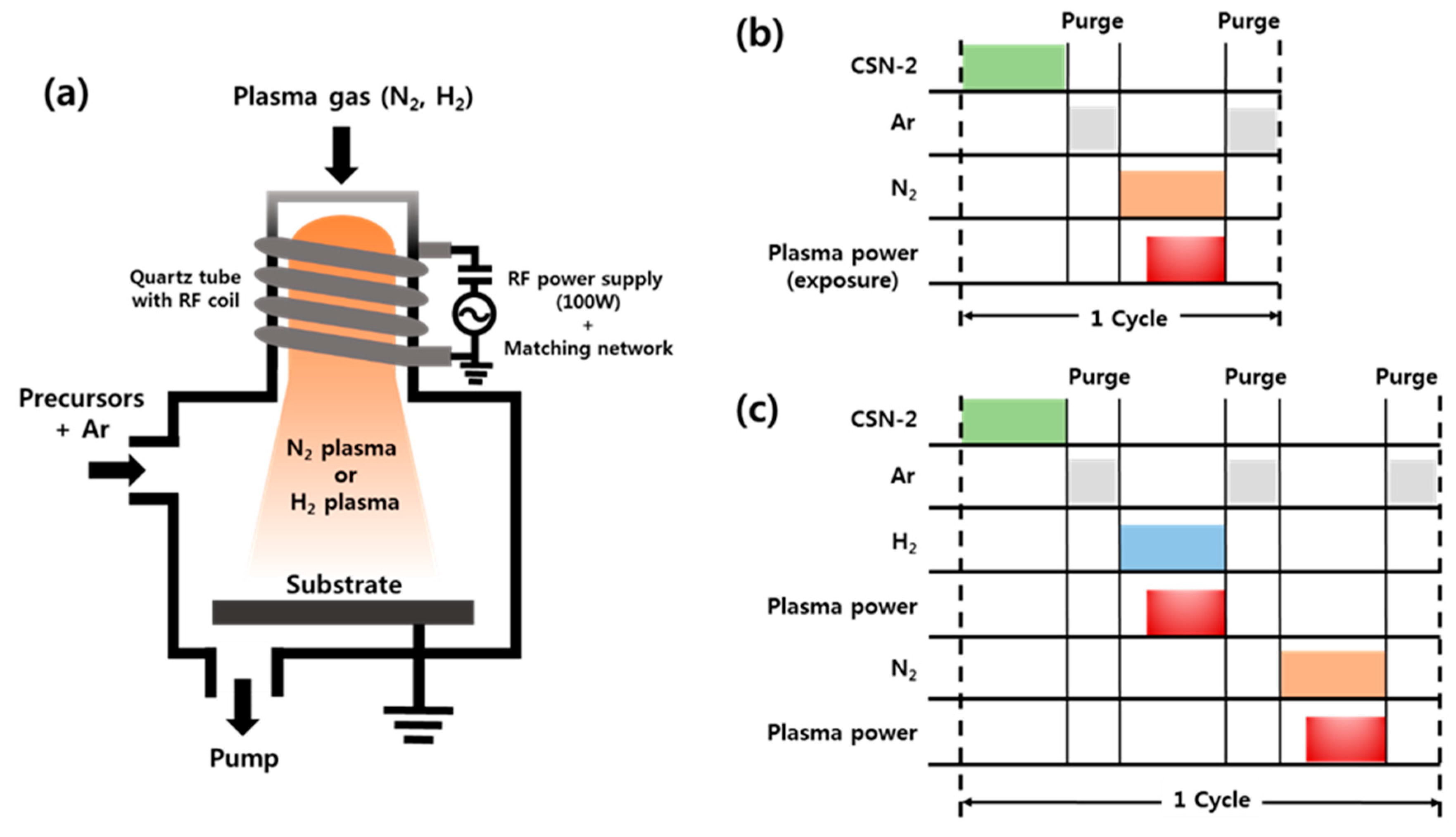
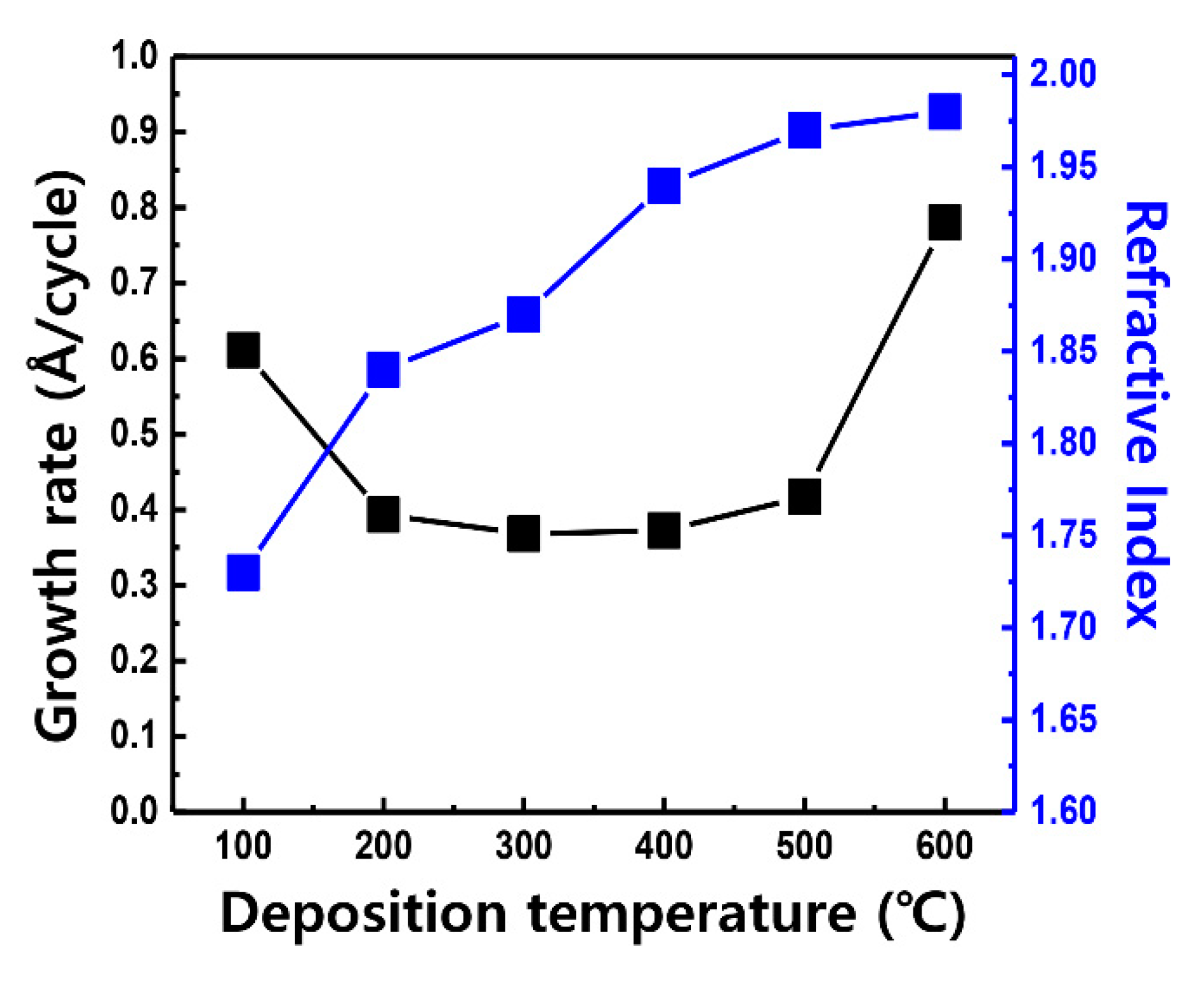


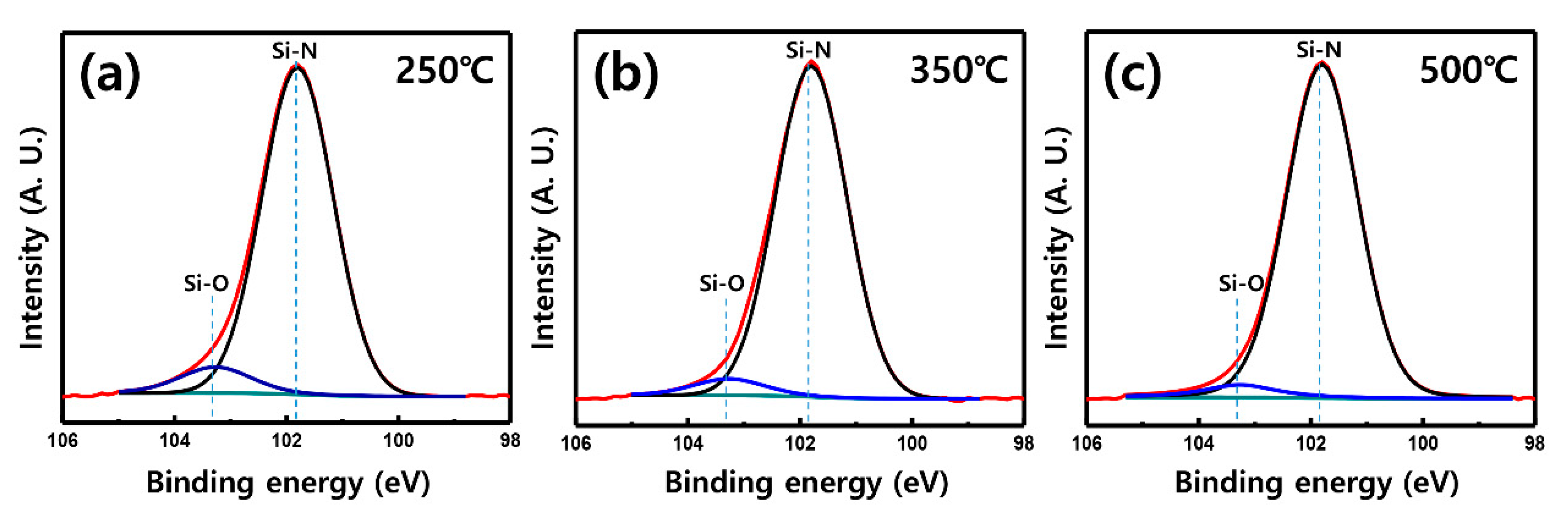
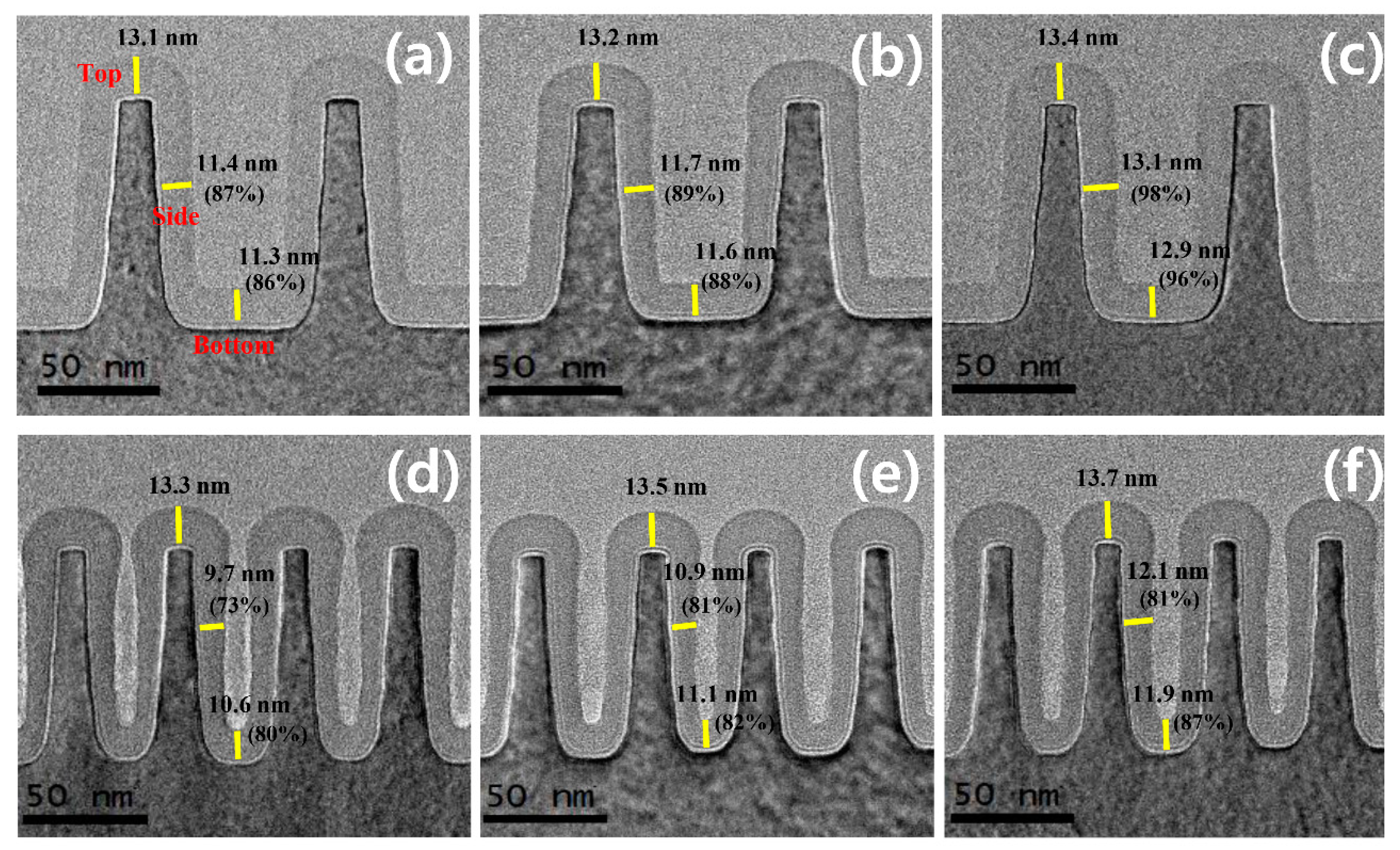
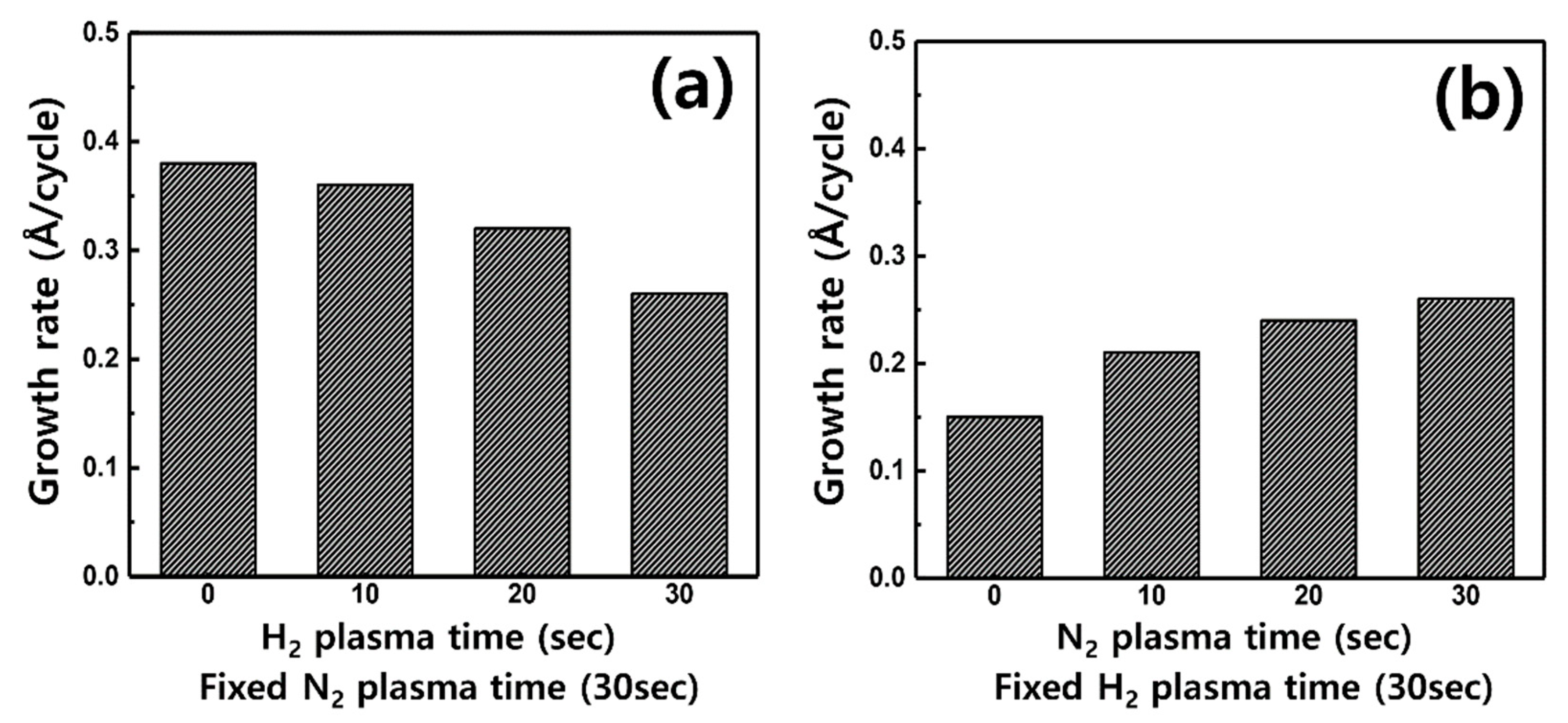

| Temp. (°C) | 250 | 350 | 500 |
|---|---|---|---|
| Wet Etch Rate (Å/min) | 57 | 43 | 35 |
| H2 Plasma Time (s) | 0 | 10 | 20 | 30 |
|---|---|---|---|---|
| WER (Å/min) | 43 | 39 | 34 | 32 |
© 2019 by the authors. Licensee MDPI, Basel, Switzerland. This article is an open access article distributed under the terms and conditions of the Creative Commons Attribution (CC BY) license (http://creativecommons.org/licenses/by/4.0/).
Share and Cite
Cho, H.; Lee, N.; Choi, H.; Park, H.; Jung, C.; Song, S.; Yuk, H.; Kim, Y.; Kim, J.-W.; Kim, K.; et al. Remote Plasma Atomic Layer Deposition of SiNx Using Cyclosilazane and H2/N2 Plasma. Appl. Sci. 2019, 9, 3531. https://doi.org/10.3390/app9173531
Cho H, Lee N, Choi H, Park H, Jung C, Song S, Yuk H, Kim Y, Kim J-W, Kim K, et al. Remote Plasma Atomic Layer Deposition of SiNx Using Cyclosilazane and H2/N2 Plasma. Applied Sciences. 2019; 9(17):3531. https://doi.org/10.3390/app9173531
Chicago/Turabian StyleCho, Haewon, Namgue Lee, Hyeongsu Choi, Hyunwoo Park, Chanwon Jung, Seokhwi Song, Hyunwoo Yuk, Youngjoon Kim, Jong-Woo Kim, Keunsik Kim, and et al. 2019. "Remote Plasma Atomic Layer Deposition of SiNx Using Cyclosilazane and H2/N2 Plasma" Applied Sciences 9, no. 17: 3531. https://doi.org/10.3390/app9173531
APA StyleCho, H., Lee, N., Choi, H., Park, H., Jung, C., Song, S., Yuk, H., Kim, Y., Kim, J.-W., Kim, K., Choi, Y., Park, S., Kwon, Y., & Jeon, H. (2019). Remote Plasma Atomic Layer Deposition of SiNx Using Cyclosilazane and H2/N2 Plasma. Applied Sciences, 9(17), 3531. https://doi.org/10.3390/app9173531




